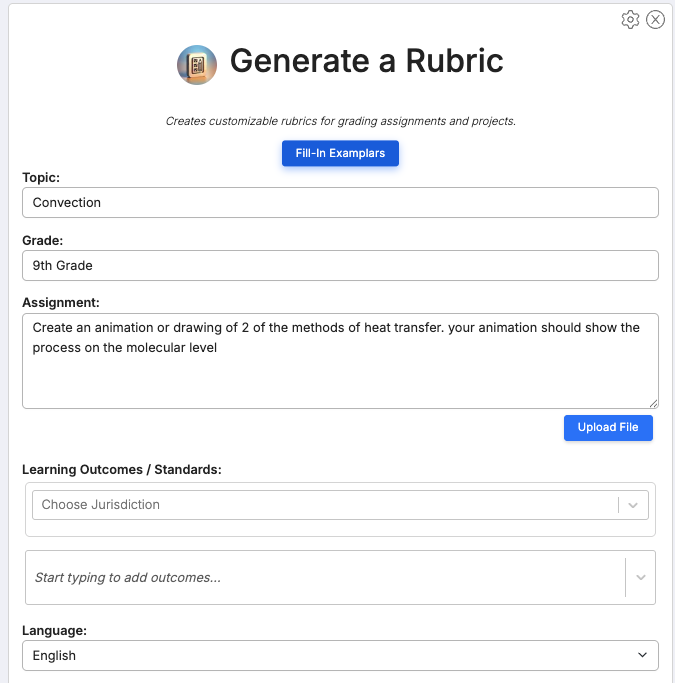
AI Rubric Generator
What makes a good rubric?
Core Components of Rubrics for Successful Learning Outcomes
-
Clear Criteria: Rubrics must have well-defined criteria that outline what is expected for each level of performance. This clarity helps students understand the goals and standards they need to meet.
-
Descriptive Levels of Performance: Effective rubrics provide detailed descriptions for each performance level (e.g., excellent, satisfactory, needs improvement). This specificity allows students to gauge their own work against the expectations.
-
Alignment with Learning Objectives: Rubrics should be directly aligned with the learning objectives of the assignment or assessment. This ensures that the evaluation focuses on the skills and knowledge that are intended to be developed.
-
Transparency: Sharing rubrics with students before they begin an assignment promotes transparency in assessment. It allows students to self-assess and understand how their work will be evaluated.
-
Feedback Mechanism: Rubrics should facilitate constructive feedback. They should not only indicate what was done well or poorly but also provide insights into how students can improve their work.
-
Opportunities for Revision: Incorporating rubrics in a way that allows for revisions encourages a growth mindset, where students can learn from their mistakes and improve their work based on feedback.
Common Pitfalls (Lethal Mutations) of Rubrics
-
Vagueness: If the criteria or performance levels are too vague or ambiguous, students may not understand what is expected of them, leading to confusion and frustration.
-
Overly Complex Rubrics: Rubrics that are too detailed or complicated can overwhelm students and detract from their focus on the actual learning objectives.
-
Misalignment with Objectives: If the rubric does not align with the learning objectives, it can lead to assessments that do not accurately measure student understanding or skills.
-
Lack of Student Involvement: Not involving students in the creation or adaptation of rubrics can result in a lack of ownership and understanding of the assessment process.
-
Inflexibility: Rubrics that are too rigid may not accommodate diverse learning styles or creative approaches, stifling student expression and innovation.
-
Neglecting Feedback: Focusing solely on the rubric scores without providing qualitative feedback can limit students' understanding of their strengths and areas for improvement.
Conclusion
For rubrics to be effective instructional strategies, they must be clear, aligned with learning objectives, and facilitate meaningful feedback. Avoiding common pitfalls such as vagueness, complexity, and inconsistency is crucial to ensure that rubrics enhance rather than hinder the learning experience.
How does this AI Tool stack up?
This AI Rubric Generator is built on these principles. Let's try it out.

Learning Outcomes / Standards:
- Understand and explain the three methods of heat transfer.
- Demonstrate the ability to communicate scientific concepts effectively.
- Apply creativity and critical thinking in the presentation of scientific concepts visually.
| Criteria | Exemplary (4 pts) | Proficient (3 pts) | Satisfactory (2 pts) | Needs Improvement (1 pt) |
|---|---|---|---|---|
| Content Quality | Animation/Drawing accurately represents both methods of heat transfer with detailed molecular interactions; demonstrates a thorough understanding of convection and another method. | Minor inaccuracies in molecular details, but both methods are mostly clear and understandable; shows good understanding of concepts. | Some inaccuracies; one method is clear, while the other lacks detail or clarity; basic understanding of concepts. | Significant inaccuracies; limited or incorrect understanding of heat transfer concepts; fails to represent methods clearly. |
| Creativity | Exceptional creativity in design and execution; animation/drawing is visually engaging, original, and enhances understanding of the concepts. | Good creativity; design is engaging and shows effort, with some original elements. | Average creativity; basic design; shows some effort but lacks originality and engagement. | Little to no creativity; design is dull, simplistic, or lacking in effort; fails to engage the viewer. |
| Accuracy | All scientific information is accurate and well-researched; effectively uses scientific terminology throughout the animation/drawing. | Most scientific information is accurate; minor errors present, with some use of appropriate terminology. | Some information shows inaccuracies; limited use of scientific terminology; lacks depth in explanation. | Many inaccuracies; lacks appropriate use of scientific terminology; fails to convey scientific concepts effectively. |
| Presentation | Animation/Drawing is exceptionally well-organized and easy to follow; clear visual flow that enhances understanding of the processes. | Mostly organized; minor issues in visual flow; generally easy to follow. | Some organization; difficult to follow at times; lacks clarity in visual representation. | Lacks organization; presentation is confusing and difficult to follow; fails to clearly represent the processes. |
| Collaboration | Worked exceptionally well with peers; demonstrated excellent teamwork and communication skills throughout the project. | Worked well with peers with minor issues in teamwork or communication; generally effective collaboration. | Some contribution; however, demonstrated limited teamwork or communication; did not fully engage with peers. | Did not work well with peers; poor communication and teamwork; minimal contribution to the group effort. |
Total Points: ___ / 20
Notes:
- Performance indicators provide clear expectations for students.
- Adjust weights and descriptions according to specific classroom needs or educational standards as necessary.

